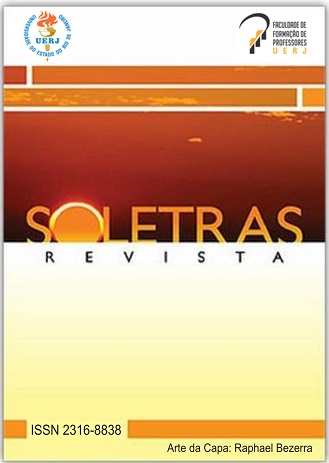Sobre links e herança construcional: uma revisão à luz da interrelação entre as construções núcleo-complemento, transitiva básica e monoargumental inacusativa
DOI:
https://doi.org/10.12957/soletras.2019.38442Palavras-chave:
Linguagens, Linguística, Construção, Rede ConstrucionalResumo
Este artigo tem como objetivo apresentar uma breve discussão sobre as noções de links e herança apresentadas no trabalho clássico de Goldberg (1995) e no trabalho de Diessel (2015) e analisar a interconectividade existente entre três construções altamente esquemáticas: a construção núcleo-completo (CNC), a construção transitiva básica (CTB) e a construção monoargumental inacusativa (CMI). Pautamo-nos, para este fim, no arcabouço teórico da Linguística Funcional Centrada no Uso (LFCU), segundo o qual a língua é concebida como uma rede de construções, ou seja, um inventário estruturado de pareamentos forma-sentido. A análise aqui desenvolvida aponta para o compartilhamento de propriedades formais e semânticas/funcionais das construções supracitadas: todas as três construções, por exemplo, apresentam a configuração verbo + sintagma nominal com caráter menos agentivo (sendo esta configuração uma subparte da CTB) e caracterizam-se pela forte tendência de apresentarem alto grau de novidade e/ou saliência da informação, assumindo, portanto, um papel mais focal.Downloads
Publicado
Edição
Seção
Licença
A aprovação dos artigos implica a cessão imediata e sem ônus dos direitos de publicação nesta revista. O(s) autor(es) autoriza(m) ao Programa de Pós-graduação em Letras e Linguística (PPLIN) a reproduzi-lo e publicá-lo na revista SOLETRAS, entendendo-se os termos “reprodução” e “publicação” conforme definição do artigo 5° da Lei 9610/98. O(s) autor(es) continuará(rão) a ter os direitos autorais para publicações posteriores. O artigo poderá ser acessado pela rede mundial de computadores (http://www.e-publicacoes.uerj.br/index.php/soletras), sendo permitidas, a título gratuito, a consulta e a reprodução de exemplar do artigo para uso próprio de quem o consulta. Casos de plágio ou quaisquer ilegalidades nos textos apresentados são de inteira responsabilidade de seus autores.



